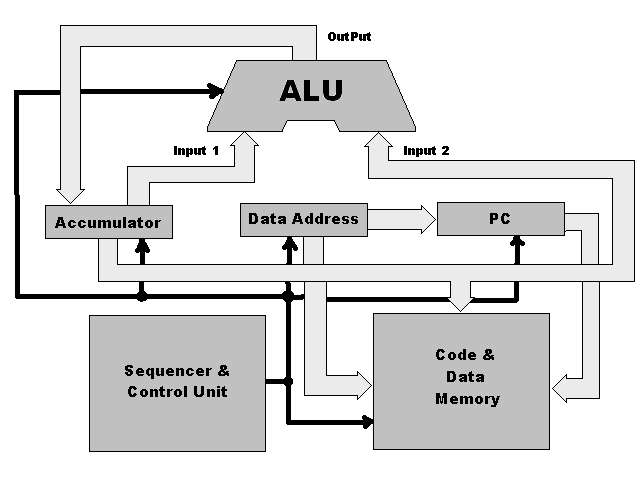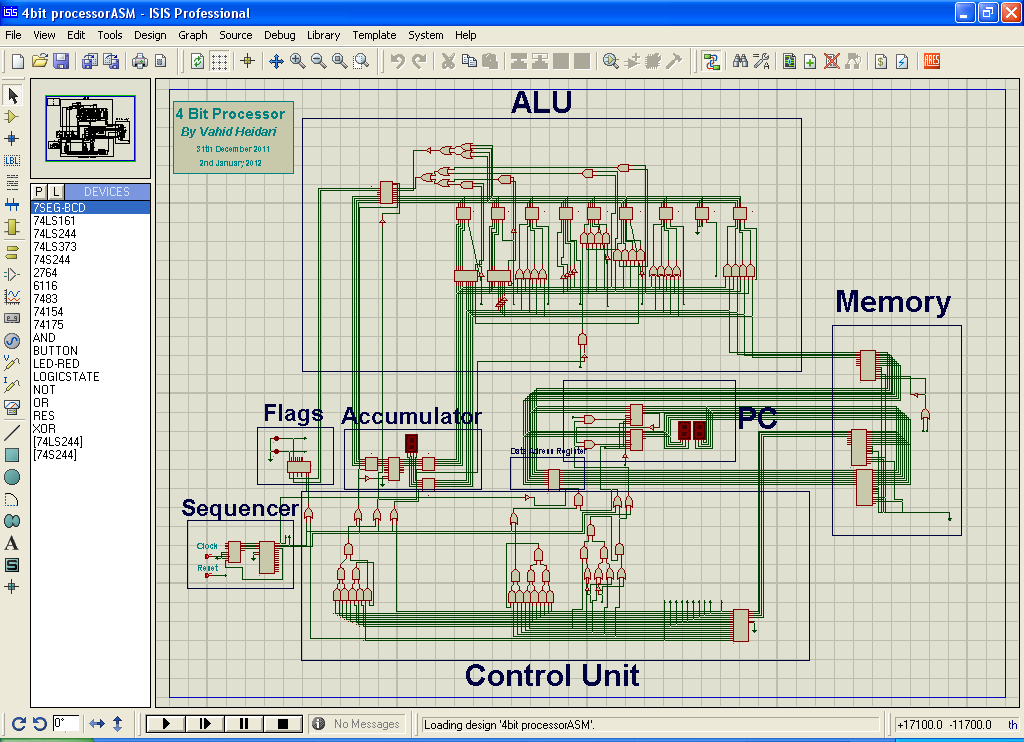This repository contains 4-bit CPU design files for my Computer Architecture Lab.
CPU E-bity means 4-bit CPU in Persian. E stands for number 4 , because I think
the E letter is the most similar letter to number 4
( ) in Arabic font :)
) in Arabic font :)
I tried to use least possible components. This processor has an accumulator, a data address counter, and a program pointer registers.
It is based on "Harvard" architecture, which means that is has separate address spaces for program and data. This architecture allows different word size for data and code. Here, data word is 4-bit wide, and instructions word size is 12-bit wide. This processor can address 256 words of code and 256 words of data, because it has a 8-bit address bus. The block diagram of this CPU is as follows:
This processor has arithmetic (add and subtract), logical (complement of accumulator, logical "or", logical "and", logical mutual exclusive "or", and left and right shift), register move, unconditional jump, conditional jump operations according to zero and carry flags, accumulator and flags clear operations. For the sake of simplicity, input/output instructions are dropped.
All operations are done in 3 clock pulses, this means that each instruction cycle takes 3 clock, then the ring counter resets to zero after 3 clocks.
On the first clock, the CPU sends the content of PC to code address bus and reads and decodes the current instruction, at the same time it copies the address of data to data address register.
On the second clock, the CPU executes the instruction and the PC increments by one.
On the third clock, the CPU saves the result and the ring counter becomes zero to perpare for the next machine cycle.
The opcode format is as follows:
xxxx dddd dddd
- x: 4 bit instruction
- d: 8 bit data address
The following table contains the instruction set for this processor:
| Description | Opcode | Instruction |
|---|---|---|
| Move Accumulator to memory | 0000 | MOV |
| Add Accumulator with data in memory | 0001 | ADD |
| Subtract Accumulator with data in memory | 0010 | SUB |
| Or Accumulator with data in memory | 0011 | OR |
| And Accumulator with data in memory | 0100 | AND |
| Exclusive Or Accumulator with data in memory | 0101 | XOR |
| Complement Accumulator | 0110 | NOT |
| Shift Accumulator left | 0111 | SHL |
| Shift Accumulator right | 1000 | SHR |
| Unconditional jump | 1001 | JMP |
| Branch if zero | 1010 | BRZ |
| Branch if carry | 1011 | BRC |
| Branch if not zero | 1100 | BNZ |
| Branch if carry clear | 1101 | BNC |
| Clear Flags | 1110 | CLF |
| Clear Accumulator | 1111 | CLA |
The Proteus 7.6 SP4 (build 8741) is used for implementation and simulation of CPU. Discrete components are used to implement different blocks of CPU according to the block diagram that depicted above. The final design is as follows:
A two-pass assembler is written to translate assembly language into machine
codes, for example consider the following assembly code, named source.txt:
BYTE A
BYTE B
BYTE C
SHL
SHL
JMP LBL
SHL
LBL: Add A
Sub B
Sub C
cla
ENDAfter running assembler, it asks source code name and output name.
If there is error(s) in input source code, messages can be found in
ErrorList.txt file. All errors must be solved, unless Intel-Hex outputs could
not be generated. When there is no error in source code, assembler creates
intermediate file source.txt.Intr, object source.txt.o, data address
source_ADR.hex, and machine code source_OPC.hex files.
Most important outputs are two Intel-Hex formatted outputs. For example output of above source code is as follows:
| Opcode Hex output file | Data Address Hex output file |
|---|---|
| `source_OPC.hex` | `source_ADR.hex` |
|
|
These files can be used in Proteus to test the CPU functionality.

